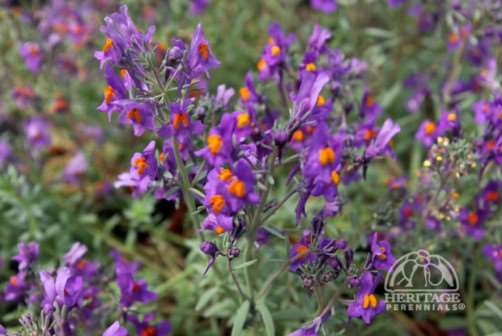Perennial Gardening with Limited Water
Perennials 101, Perennials for Special Purposes
 1. Water is not an endless resource
1. Water is not an endless resource
In various regions of North America the supply of clean fresh water for human consumption is becoming a less available resource. Many urban areas have had to place bans or tight restrictions on residential use of treated water for lawns and gardens. Even gardeners in rural areas often have the supply limitations of wells and cisterns to consider.
2. Invention of Xeriscaping™
Because of these water limitations, an alternative way of gardening has been developed. Beginning in the Denver area in 1981, the term “Xeriscape”™ was invented to describe the conservation of water through creative landscaping. A whole new way of gardening has resulted, which varies widely from region to region. Despite the image of cactus and gravel that many people first envision, this style of gardening does not have to look bleak or stark.
3. So how does it work?
The method focuses on grouping plants together in the garden according to their water needs. This makes a lot of sense, when you think about it. In simple terms, group the thirsty plants together and put those plants that tolerate drier conditions in a different area. By doing this, we are watering only those areas that absolutely need it, thereby conserving water by not applying it unnecessarily.
4. Where do I start?
Begin by evaluating the plants in your own garden and their placement. Are there plants you can think of that often look wilted or dry during hot, dry periods? Are these dotted throughout the garden, and perhaps planted next to more drought-tolerant varieties? It might be a good idea to consider moving those heavy water-users together so they get watered at the same time. Simple enough!
5. Planning from scratch
This is even easier still. When planning for new beds or borders, try to include only plants that have similar water, soil and light needs together. Locate beds that need regular watering as close to the house as possible so you remember to water them, drier beds can go further out in the garden. Take advantage of any naturally wet spots in the garden by planting water-loving plants near them, for instance where the downspouts drain onto the ground, or a low spot in the garden that stays constantly moist.
Your local nursery or garden center may have other plants that they can suggest. Seriously consider using some plants that are native to your area!
6. Mulching is the key
Covering the soil surface with an organic mulch of some kind will greatly reduce the amount of water lost to evaporation, because it reduces the soil temperature, and provides protection from drying winds. A mulching depth of two to three inches appears to be sufficient under most circumstances. Be careful to reduce the amount of mulch directly at the crowns of perennials and woody plants, to prevent them from rotting off during wet weather.
Choose a material for mulching that is free of weeds. Some good mulching materials include: compost (commercial or home-made), composted manure, mushroom manure, shredded bark, pine needles, shredded leaves or leaf-mold, dried grass clippings, cocoa beans. Check locally for other inexpensive alternatives.
Some gardeners are experimenting with gravel or sand as a more long-lasting alternative to organic mulches. These can also be very effective, and attractive.
7. Learn to water wisely
- Find out what watering restrictions may apply in your municipality. This is usually announced in the local newspaper or on the radio. Some regions even have water police who will issue hefty fines to those who water indiscriminately.
- Let the plants tell you when they are thirsty. Learn to watch for the first signs of drought stress or wilting, and let that be your guide.
- Try to avoid watering during the heat of the day, say between 10 am and 6 pm. A large portion of the water applied during those hours will end up evaporating and not even hit the ground.
- Water deeply but not often. Check with a trowel or spade to see how deeply the water has gone. It should penetrate a good four inches or so, in order to do any good.
- Put water only where it is needed. There is no sense in watering the patio or driveway, so try and get the water onto the area where the plants are. Check your local garden center to see what sorts of sprinklers and watering systems they recommend for your situation. Some of the new porous soaker hoses are especially good for reducing water waste.
8. Make use of regional resources
Find out if there are any local water-wise demonstration gardens nearby. Botanical gardens, large city parks and zoos are good places to check. Your local garden center may have information available on what works specifically in your area. Members of the local Horticultural Society or Master Gardeners may be facing similar problems, and they are usually a wealth of knowledge!
9. All perennials need regular watering for the first season
Even the most drought tolerant perennials still need your help while they are becoming established. Planting during cool spring or fall weather is a great way to reduce the watering needs of young plants. They will develop strong, healthy root systems that are better able to cope with summer drought and heat. Drought tolerant perennials should be able to fend for themselves after the first season, with only occasional watering necessary during extremely dry weather.

Red Lady’s-fingers (Anthyllis vulneraria var. coccinea)
For a list of perennials which are drought tolerant, use our advanced search feature and select ‘drought tolerant’ as a characteristic.